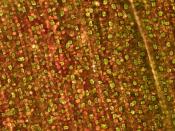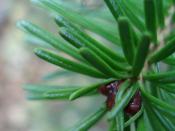Aim: To investigate and compare the distribution density of stomata in the upper and lower epidermis of a dicotyledonous leaf.
Stomata are the principle means of gas exchange in plants. Stomata are small pores they are controlled by guard cells which control the opening and closing of stomata. Stomata allow carbon dioxide to enter the plant, and allow water and excess oxygen to escape. About 90% of water is lost from the leaf during transpiration.
The number of stomata on leaf surface varies among different species. The lower epidermis tends to have the most number of stomata than the upper surface.
In order to carry out the experiment 3 methods were used:
(1) Calibration of the eyepiece graticule- done in order to work out field of view area.
(2) Counting of the stomata using the microscope.
(3) Calculating stomata density.
Equipment:
Eyepiece graticule
Microscope
Stage micrometer
Dicotyledonous leaf ? ivy
Clear nail polish
Glass slide
Clear tape
Method 1
Place the graticule scale into the eyepiece of the microscope.
This is done by unscrewing the top lens and dropping the scale into the lens body. Then screw the top lens back on. Put the stage micrometer on the stage and hold in place by the clips. Look through the microscope and focus at x40 so you can see both scales clearly. Move the stage micrometer carefully so that the starting units of the two scales coincide. Count along the two scales until there is again a coincidence between the two scales. Note the number of divisions along each scale. Repeat for x100 and x400 magnification.
Method 2
On the upper surface of the leaf paint a thick layer of clear nail varnish. Allow the leaf to completely dry. Once it has dried stick a piece of clear tape over the...


